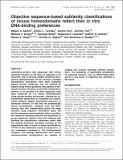Objective sequence-based subfamily classifications of mouse homeodomains reflect their in vitro DNA-binding preferences
Author(s)
Santos, Miguel A.; Turinsky, Andrei L.; Ong, Serene; Tsai, Jennifer; Berger, Michael F.; Badis, Gwenael; Talukder, Shaheynoor; Gehrke, Andrew R.; Hughes, Timothy R.; Wodak, Shoshana J.; Bulyk, Martha L.; ... Show more Show less
DownloadSantos-2010-Objective sequence-based subfamily classifications.pdf (6.817Mb)
PUBLISHER_CC
Publisher with Creative Commons License
Creative Commons Attribution
Terms of use
Metadata
Show full item recordAbstract
Classifying proteins into subgroups with similar molecular function on the basis of sequence is an important step in deriving reliable functional annotations computationally. So far, however, available classification procedures have been evaluated against protein subgroups that are defined by experts using mainly qualitative descriptions of molecular function. Recently, in vitro DNA-binding preferences to all possible 8-nt DNA sequences have been measured for 178 mouse homeodomains using protein-binding microarrays, offering the unprecedented opportunity of evaluating the classification methods against quantitative measures of molecular function. To this end, we automatically derive homeodomain subtypes from the DNA-binding data and independently group the same domains using sequence information alone. We test five sequence-based methods, which use different sequence-similarity measures and algorithms to group sequences. Results show that methods that optimize the classification robustness reflect well the detailed functional specificity revealed by the experimental data. In some of these classifications, 73–83% of the subfamilies exactly correspond to, or are completely contained in, the function-based subtypes. Our findings demonstrate that certain sequence-based classifications are capable of yielding very specific molecular function annotations. The availability of quantitative descriptions of molecular function, such as DNA-binding data, will be a key factor in exploiting this potential in the future.
Date issued
2010-08Department
Harvard University--MIT Division of Health Sciences and TechnologyJournal
Nucleic Acids Research
Publisher
Oxford University Press (OUP)
Citation
Santos, M. A. et al. “Objective Sequence-based Subfamily Classifications of Mouse Homeodomains Reflect Their in Vitro DNA-binding Preferences.” Nucleic Acids Research 38.22 (2010): 7927–7942. Web. 1 June 2012.
Version: Final published version
ISSN
0305-1048
1362-4962